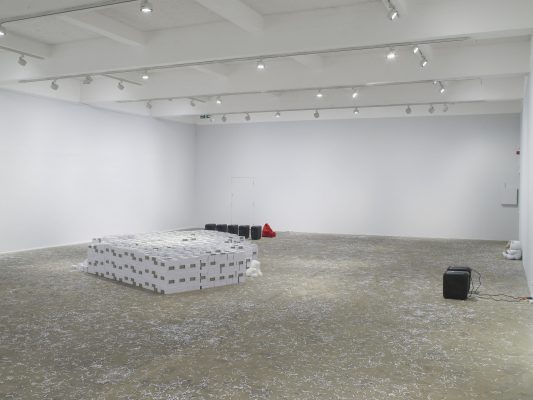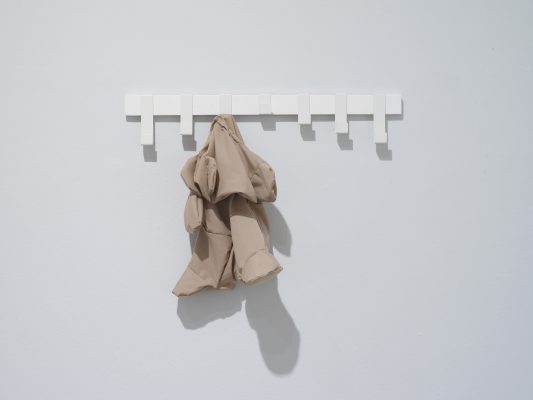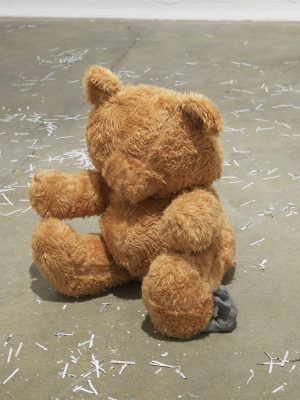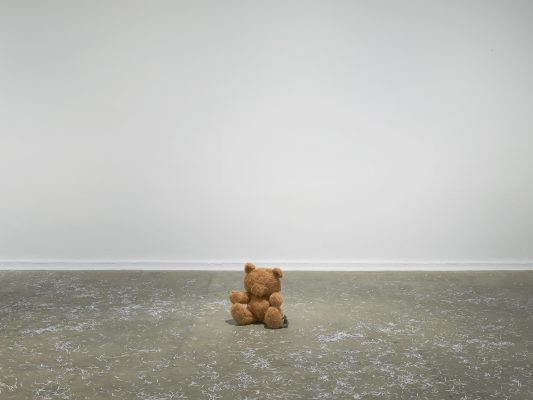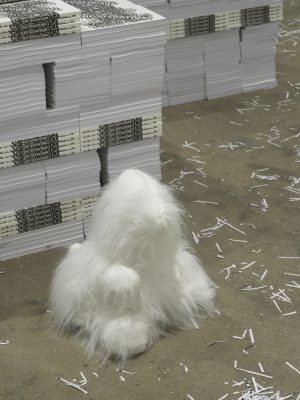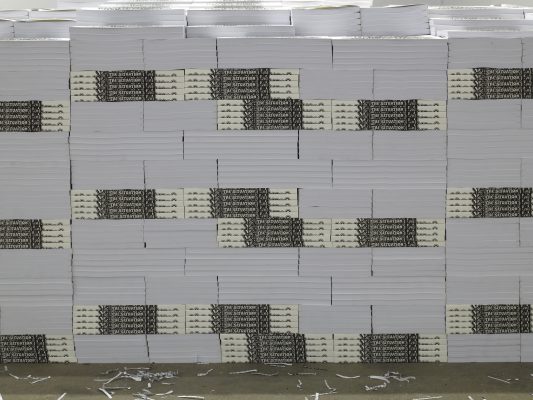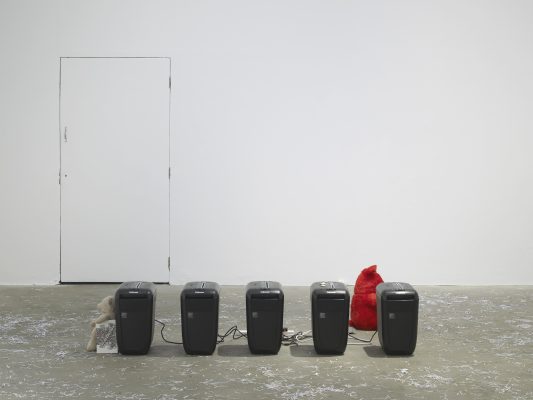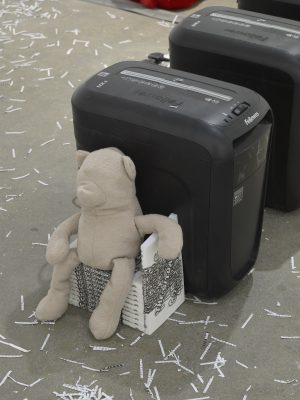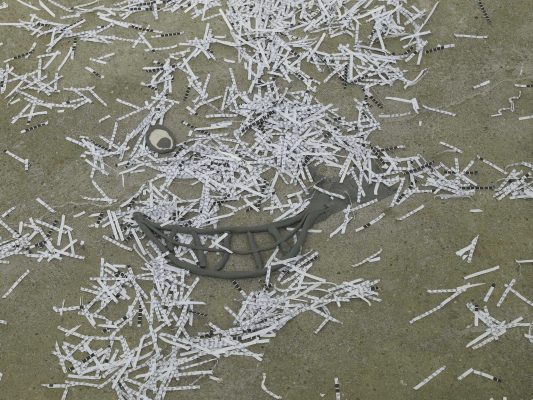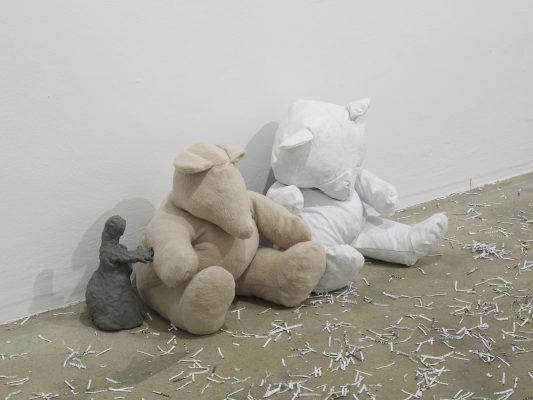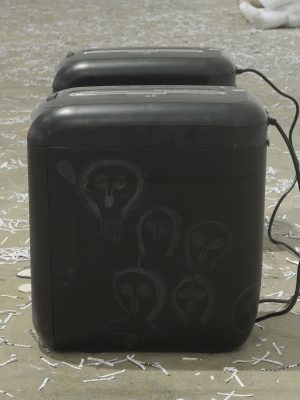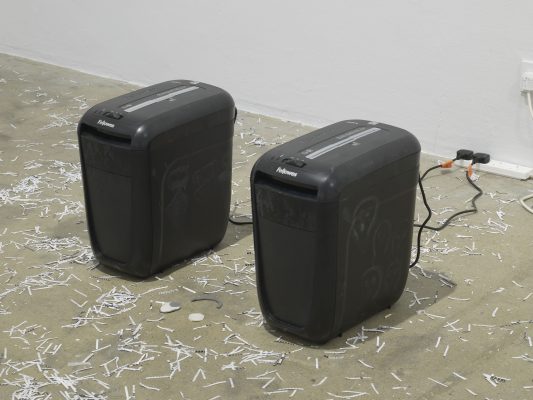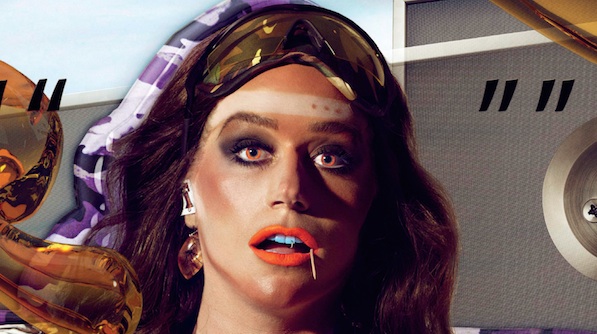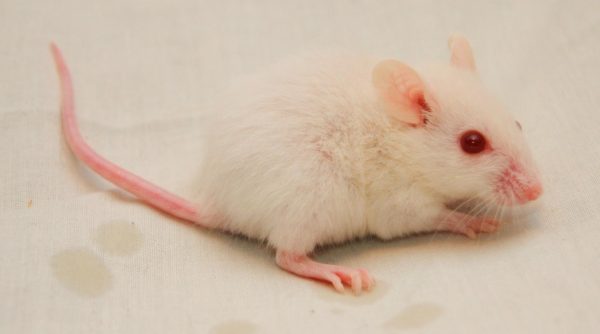On the cover of the 1985 Pelican edition of D. W. Winnicott’s 1971 book, Playing and Reality, there is a picture, by Lawrence Mynott, of a teddy bear with a missing plastic eye. Winnicott is famous, of course, for talking about teddy bears. He writes: ‘the object is affectionately cuddled as well as excitedly loved and mutilated’. One must, he notes, ‘recognise the central position of Winnie-the-Pooh’ in the life of the child. Teddy bears without eyes and Winnie-the-Pooh-type creatures turn up quite a bit in Hannah Black’s Some Context (2017). There are seven Transitional Objects scattered about the gallery space. These visionless fabric animals, some bears, some dog-like, one elephant-like (the latter hung up on some metal hooks), are filled with shredded copies of a text called The Situation, 20,000 copies of which (bar those that have been taken and/or shredded) form a strange temple-like monument in the middle of the room, guarded by an animal with long silky hair that looks like someone’s idea of an Afghan hound if they had never seen one.
The floor, entitled Carpet, is covered with already-shredded pages from the book, and in odd clearings, there are Creatures made of modeling clay – some are faces, some are eyes, perhaps the missing eyes of the toys – and others are figurines, clutching at the side of the fabric animals. One is just a smear, though perhaps it has been stepped on, as differentiating the curious crunch of shredded paper from the partly hidden modelled objects makes wandering around the show rather delicate. In three sites, menacing paper shredders, switched on and full of eaten paper, add an air of dangerous possibility – should I shred the book? Is that what the machines want? Is that what the artist wants? On the back of the book two small diagrams show a bear-like creature throwing the book up into the air as it appears to explode, and another shows the bear walking off with the book under its arm. I followed the second bear.
All this anxiety, uncertainty and possibility is perhaps part of the point – after all, what is ‘the context’ that this show demonstrates ‘some’ aspect of it? What exactly is ‘the situation’ that the book describes? Comprised of interviews with many people – some with their names obscured and some mentioned at the back, and none tied to the body of the text so you don’t know who’s speaking – the book both is the show and is about the show. The transcripts, sometimes tentative, sometimes impassioned, often blacked out as if censored, speak of many different kinds of ‘situations’. Some of these are structural (patriarchy, sexual and physical violence, colonialism, racism, capitalism, environmental destruction) and others institutional – the relationship between artists of colour and art institutions – though it is hardly as if institutions are separable from the structures that dominate them. As one voice puts it: ‘Maybe the situation is a question of reparations in the representational context’.
Black’s show poses this exact question in multiple ways: what is the relationship between reparations as a political, historical and economic demand, and reparations in the context of art? Are they separable? What do different groups of people owe objects, transitional or otherwise, and what do they owe us? What do we owe the written word, and when should we read, and when should we destroy? By posing the possibility of the destruction of the words of black artists, shredders awaiting, Black points to uncomfortable realities, both historical and current. Is assimilation and invitation (always selective, of course) just the latest iteration of the long history of institutional neglect, theft and exploitation of black artists?
As one interviewee in The Situation puts it:
It’s like this Malcolm X line in the Fred Moten book … something like: ‘what we have to remember when we’re dealing with the white man is that we are dealing with a very silly man.’ These are very silly people. They’re easily disturbed by minor things. You’re fine, don’t worry, no Nazis are going to burn any of your books.
The teddy bears of Some Context are perhaps a (disturbing) comfort, but the time has come to put away childish things. Playing and reality – ‘the situation’, played out in multiple ways, is the horror of reality, the reality of violence against blackness, the reality of representation as intimately tied to racism, colonialism, capitalism, whiteness.
Some Context is strange and idiosyncratic, but also a deeply collective work – not just with the speakers in Black’s book – but also with the collective experience of childhood. But who gets to grow up, and who doesn’t? If there is an object here, it might be white infantilism, and if there is a subject, it is a double one of the black child, killed as if they were an adult, and the black artist, forced to negotiate the dangerous, because easily disturbed, silliness and power of the white man and his white cubes.
